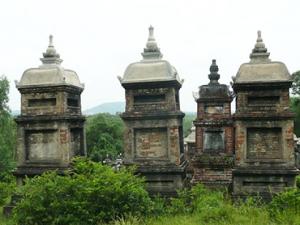Bo Da Pagoda: Home to Sacred Buddhist Treasures

Because of its natural, diversified, and abundant terrain, the northern province of Bac Giang is an ideal destination for eco-tourism, resort, weekend and adventure trips. Tourists look forward to witness its beautiful landscape. But for anyone who comes by, a visit to Bo Da Pagoda in Thuong Lat Hamlet, Tien Son Commune, Viet Yen District would bring a more meaningful and unforgettable experience.
The pagoda, built in the 11th century under the Ly dynasty (the golden age of Buddhism in Vietnam), cradles Buddhist woodblocks and ancient architecture that has been preserved for hundreds of years. Many of the structures and artifacts were damaged during the many wars in subsequent centuries, but during the revival of the Le dynasty under King Le Du Tong (1705-28) it was reconstructed and maintained to its present condition.
Also called Quan Am (Goddess of Mercy) or Bo Pagoda, this sacred place is situated at the foot of a hill of pines, beautiful and quiet, surrounded by walls of soil, with mountains and rivers at the distance. Its name Quan Am was born surrounding a legend about the appearance of the Goddess of Mercy to a poor childless couple, who after building the pagoda to worship her, was given a son. Many also claimed to have their wishes granted after offering prayers to the Goddess in the pagoda.
Bo Da Pagoda plays a major role in the promotion and development of Buddhism in the country. Every year, monks and believers from across the country come here to meditate and learn the faith. Inside the structure is a wealth of documents and artifacts that holds priceless culture, history, architecture and fine arts. Appearing to be a closed structure from outside, but is comprised of hundreds of compartments on the inside, all open into one another, the pagoda provides visitors with a sacred, secluded refuge from the outside world. Its walls and gates are made from packed earth 0.8m in thickness and 2-3m high. This is an ancient building technique which distinguishes this pagoda from many others. Everything in this old pagoda has a distinct brown soil color: the wall, the tiles, the big water jars and the decorative pots.
Because of the great influence of Lam Te Buddhism, most of the pagoda's famous carved woodblocks bear the oldest Buddhist texts in Vietnam, the Sutras of Zen Buddhism. A remarkable collection of over 2,000 Sutra woodblocks are arranged on eight bookcases. The larger ones are laid on the tables for visitors to see. All these blocks were carved on thi wood which to this day, has remained in great condition even without preservatives.
For many, the most interesting scene in the pagoda must be the field of old tombs along the hill, which are said to be of the chief monks of the pagoda and some others. Outside Bo Da Pagoda is an 8,000sq.m Tower Garden encircled by an old brick wall. The towers here are made of stone and solid brick, mostly 3-5 meters high, each inscribed with the days of birth and death of the monks, are a valuable source for researchers of Lam Te Buddhism. You need to climb up the hill to visit another tower. The 97 towers hold bone-ashes of more than 1,000 monks of Lam Te Buddhism.
A famous attraction in the pagoda is the annual festival. Celebrated every February 16-17 of the lunar calendar, it attracts crowds of monks and common people from different places around the country to worship and enjoy the sight. Visitors who get the chance to attend the Bo Da festival will witness famous folk music presentations performed by young locals.









